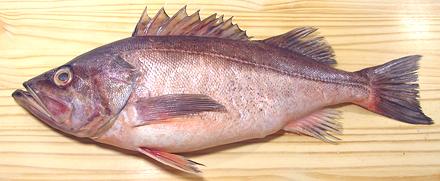 [Sebastes paucispinis]
[Sebastes paucispinis]
This rockfish is found from along the Aleutian Islands of Alaska down to at least the Mexican border. It can grow to nearly 36 inches and 21 pounds, but the photo specimen was 21 inches and 4 pounds, a little larger than average market size. This is a prized eating fish but it's IUCN Red Listed as CE (Critically Endangered) and the catch is restricted in California. Commercially Bococcio fillets are often mixed in with fillets of other rockfish.
More on Rockfish
Bococcio flesh is tender, nearly white and has excellent flavor, light but not insipidly so. There is a thin layer of darker flesh right under the skin, mainly at the tail end, which is not noticeably stronger in taste.
The flesh holds together well for most types of cooking. It holds together well enough for light poaching, but will break up fairly quickly simmered in soup, but the flakes are very large so this may not be a problem. It is excellent poached or lightly powdered with rice flour and pan fried. It is not suitable for "whole fish" recipes because of skin shrink.
Buying: Bococcio is highly restricted but can sometimes be found in Asian markets in Los Angeles. It is a premium fish, but can sometimes be found on sale at as low as US $2.99 per pound. In other markets it may be sold as fillets mixed with other rockfish.
Scales: Bococcio is covered with medium size scales that scrape off fairly easily and fly about only moderately.
Cleaning: There's nothing unusual in cleaning this fish, but the throat is quite strong, so cut it off with kitchen shears. The gills are large and fairly firmly attached, so cut them out with kitchen shears also. Do be careful with the dorsal spines, they are exceedingly sharp and reputed to be venemous.
Fillet: Bococcio is fairly easy to fillet with an easy to follow fin and bone structure, and the flesh holds together well. First cut off the head, turning the knife steeply under the gill covers to get the maximum amount of flesh. Outline the fillet by cutting through the skin along the top, across the tail and especially along the bottom. Cut from the top down following the bones to the backbone. Hop over the backbone at the tail and work forward. When you get to the ribcage just cut the ribs loose from the backbone with kitchen shears and pull them from the fillet with long nose pliers. They pull fairly easily and take almost no flesh. There are some very substantial centerline spines for the length of the body cavity but they are easy to locate. Pull them straight forward and they will come out fairly easily and cleanly. Method.
Yield: A 4 pound fish yielded just over 2 pounds of skin-on fillets (50%) and 1 pound 14 ounces skin-off (47%). Fillet weights include the skirt which is fleshy and quite usable (if your fish was fresh). There will still be some flesh around the pelvic (bottom) fins which can't be removed until after a short simmer.
Skin: Skin shrink is fairly strong and doesn't release from the flesh easily. Chunks of fillet can be pan fried skin-on by letting them cook almost all the way through before turning skin side down, then hold flat with the turner. The skin has no strong or "off" flavor. The skin is thin but quite strong, and it's adhesion is poor. You can almost peel it off so it's very easy to remove by the standard long knife and cutting board Method. Almost no flesh should be lost. I do recommend cutting off the skirt area and skinning it separately, otherwise the fillet is very wide.
Stock: The head, fins and bones simmered slowly for 30 to 40 minutes make a fairly light colored stock with moderate oil, but I didn't like the flavor. If you do use the stock, remove the oil using your gravy separator.
sf_rfbococz 110715 - www.clovegarden.com